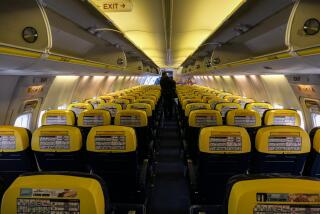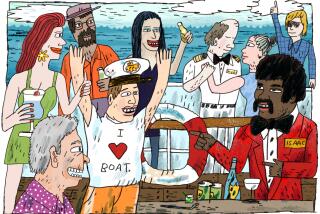Meeting a Different Kind of Cruising Challenge
Cape Horn may seem like an odd destination choice for a cruise, but for my husband and I it was the culmination of a longtime dream.
We’d first talked about it in the halcyon days of our youth, when we labored together sailing our Star boat. We made the promise again and again, while sailing on San Francisco Bay or in the warm waters of the Caribbean. But raising a family, business responsibilities and then a progressive muscular disease I contracted delayed the plans.
What fun, then, to find that we could make this voyage by cruise ship, on the Royal Viking Sky. For even though years had passed, the desire to “round the Horn” had not.
It presents the same challenge to a sailor as Mt. Everest does to a climber. And the 20,000 miles we covered getting there and back was a wheelchair saga that left me feeling as adventurous as a Magellan or Chichester.
Even on the Sky, with its radar and satellite position finder, there’s still no promise of seeing this rugged sentinel that marks the boundary between the Atlantic and Pacific oceans, just 600 miles from Antarctica. The itinerary cautiously says “weather permitting,” and we knew that on the previous cruise it had been too rough to attempt.
Well, we were lucky. The gods and nature smiled on us, for we did fulfill our promise on a dark and forbidding morning. Rising at 5:30, hoping for an early glimpse of this rocky island, my husband Bob headed to the deck bundled up like a sailor from clipper ship days.
That’s the captain in him, and he stayed on deck every cold moment until the Horn was far behind us.
I, as the imaginary first mate, was delighted to discover that our promenade deck windows looked out at exactly the same vista. So I did my rounding of the Horn, snuggled into my warm bunk, sipping hot coffee from my bed tray, happily aware that for me, at least, the luxurious ship offered a lot more comfort than a 45-foot sloop.
En route to Cape Horn, we first visited friends in Santiago, then flew to Rio for a Royal Viking pre-cruise stay. Our two-week cruise was slow-paced, with stops in Santos, Montevideo, Puerto Madryn (near a nature preserve on the Patagonian coast), a transit of the Strait of Magellan, then on to Ushuaia, the most southerly city in the world, Cabo de Hornos and a leisurely four-day sail back up to Buenos Aires.
What we did and what we saw in the course of those 20,000 miles would make a good itinerary for anyone. We just happened to do it with me sitting in my wheelchair. The special difficulties we faced and the special efforts we had to make showed our South American neighbors our true desire to learn about their countries and their cultures.
Pre-planning: In wheelchair travel it’s best to accept the fact that there will be problems. But advance planning can minimize them. Our travel agent contacted Royal Viking Lines, explaining my medical problems (muscular dystrophy) and the fact that I needed full-time use of a wheelchair.
I followed this with a personal call to again alert the cruise line that I could not climb steps; that’s important because buses are the normal mode of shore transport. Many passengers have lesser mobility problems, using a chair just as an aid, so it’s necessary to let them know that you’re a “permanent occupant.”
Select the best cabin you can afford--it means more space, a larger bath, wider hallways. I cut corners on my grocery budget for months to splurge on the promenade deck because of the scenic view from its big windows. I love to watch the constant parade of walkers, joggers and strollers.
Try for mid-ship location, close to an elevator. Make your dining room selection well in advance. We prefer a table for two by the window, but you may have to beguile the maitre d’ once aboard to get one.
Arm yourself with what reading material you can find. There are good general books on South America, and Royal Viking provides excellent shore excursion descriptions ahead of time, as well as daily sightseeing highlights in their on-board newspaper.
Airline reservations should be made early. Again, try to budget for business- or first-class. Buenos Aires to San Francisco is a long flight, and the comfort of reclining chairs and leg room was invaluable. I gave up shopping for gems in Rio and furs in Buenos Aires, and it was a good trade-off.
If flying tourist-class, request bulkhead seating. You’ll be boarded first and deplane last. And the wonderful passenger agents will become instant best friends; they know all the elevator secrets and usually whip you through customs so fast that agile passengers enviously eye your wheelchair.
If you arrive a day or two early to rest up before your cruise, all the better. And if you can break a long trip with an overnight, consider that, too. Be prepared for any kind of carry-on and carry-off if there’s not a jetway.
You’re not in the United States, with its super equipment, and loading and unloading can vary from traumatic to harrowing, especially when another language is involved. We always ask for the special narrow chair that airlines are supposed to have, but I’ve finally learned to close my eyes, pray and hope the men who carry me are both strong and sure-footed.
As for toilets, use the terminal bathrooms (or perhaps an employee or restaurant bathroom if you’re lucky). Bob has to lift me, so we enter a deux in any ladies room (occasionally even a men’s room) and no one seems to mind. Sometimes I use the bathroom on board before takeoff or at landing (no motion and safer.)
Since the dimensions of a plane toilet are designed for anorexics, we try to avoid our lifting routine there since it leaves both of us face to face with barely enough room to breathe.
I limit liquid intake for 24 hours before a trip, drink very sparingly during a trip and, on our last trek, I tried atropine, under my doctor’s instructions. It actually absorbs liquid within your body, and I managed 8- to 10-hour trips (aloft and on tours) without needing comfort stops. But use it only under a doctor’s supervision.
Another advance task is packing. All of my clothes go on a metal hanger with a plastic bag. Bob has to cope with my unpacking, and I try to keep him happy at all costs. It’s much easier, too, especially in a 30-inch case.
Which brings me to the last bit of pre-planning advice: a physically able traveling companion. That’s in the ship’s rules, and I’m lucky mine is trained as an engineer, a gentleman and a banker.
Once aboard: Yes, there are still things to do aboard. Cruising is a wonderful, relaxing way to vacation, far less tiring than land travel, but you won’t find perfect access, even on the five-star Royal Viking Lines. Of 600 passengers, there were three of us in wheelchairs and probably 25 to 30 others who had mobility problems.
Learn the floor plan of the ship. With its blueprint in mind, there’s literally no place that is off-limits to you. The easiest access to the promenade deck was through the Finlandia bar, with waiters willing to open the door and assist at the two steps. Bob soon discovered a special toggle switch on the elevator panel that held open the door for safe loading.
If you’re headed for a floor show, arrive early; there’s no such thing as a subtle entry by wheelchair. Even the beauty shop was designed so I could stay seated. Our favorite spot was the Discovery Lounge on the top deck, with its stunning view of the sea and beautiful harp music at the tea and cocktail hours.
Shore excursions: These can be difficult if you can’t manage bus steps. Our mentor was the director, Sigrid Scatliffe, who always knew what was possible. We decided early on that we needed a private car and guide, which she arranged. But know in advance that you must be flexible.
Debarking at a wharf is relatively simple, but at anchor it can be difficult. My greatest desire was a catamaran ride at the Beagle Channel, and they somehow did load me.
It must have looked exciting, too, because when the crew finally deposited me and the chair inside, I was greeted by a round of applause. But I really didn’t know if we could do it until minutes before.
If you plan pre- or post-trip excursions, let them know that you’ll need taxis rather than buses. And arrange touring with your own car and guide. It costs more but you learn more. I always let hotels know my special needs: the Sheraton in Rio and the Plaza in Buenos Aires were wonderfully helpful to us.
The personal touch: You may not have time for a Berlitz course, but do at least try to learn the words for “wheelchair,” “elevator,” “help” and “steps.” And especially “thank you.” Fortunately, I am fluent in Spanish, but it was great fun learning these words in Portuguese. And my obrigada (thank you), accompanied by a gracious smile, made the difficult job of lifting a happier experience. It was often more important than the tip.
I consider it the personal responsibility of any “wheelie” traveler to put others at ease. Somehow, coping with a wheelchair leaves onlookers tongue-tied. I find I often have to initiate conversation to let them know that my disability does not extend to my brain, thankfully.
And I find room in my luggage for my best-looking clothes. Somehow, people connect wheelchair users with hospital gowns, and I take great delight in donning chiffon, sequins, paisley shawls, gold lame--whatever makes me look and feel stylish.
But underneath this finery must be a will of steel, for often it’s a fight every inch of the way to get where you want to go. So develop a “politely aggressive” attitude, never be afraid to ask others for help, remember to be flexible and above all, retain your sense of humor.
I pack my sense of humor every day, long before I dress, and it solves most of the problems of being “physically challenged.”
For instance, the only flat entry into the very elegant Plaza Hotel in Buenos Aires happened to be in a loading area for the legumbres (vegetables). Somehow, it gave us a great chuckle to roll in right along with the “tomates, lechuga y zanahorias” (tomatoes, lettuce and carrots) that would appear in our dinner salad at the famed Grill that evening.
More to Read
Sign up for The Wild
We’ll help you find the best places to hike, bike and run, as well as the perfect silent spots for meditation and yoga.
You may occasionally receive promotional content from the Los Angeles Times.






